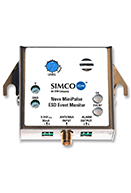
The Novx MiniPulse ESD Event Detector is designed for tool and process monitoring. This affordable, small footprint embeddable monitor has been developed to warn of product damage risks at the point of electrostatic discharge. The MiniPulse uses time domain and threshold discrimination to detect pulse electromagnetic energy. Through the use of specific antenna configurations and placement, the MiniPulse can provide ESD event detection for well-defined small areas.
○ Small Footprint
○ Can easily fit inside a tool or in a manufacturing line
○ Red/green LED alarm; audible alarm
○ Visual and audible alarms of ESD events
○ Open Collector Output on Alarm
| Power | 9-24 VDC ---, 30 mA (9V alkaline battery option can be used to provide up to 20 hours of operation, no ground required) |
| Power Input Connector | 0.100” header, locking, 2-pin 0.025” square right angle posts (mating connector is a Molex 22-01-3027, TE Connectivity 3-640440-2 or other equivalent connector) |
| LED Indicators | Green NORMAL OPERATION; red ESD EVENT |
| Audible Alarm | Piezo buzzer sounds momentarily on ESD event |
| Alarm Output | Open collector pulls to GND on alarm +24 VDC max; 0.2A load max |
| Alarm Output Connector | 0.100” header, locking, 2-pin 0.025” square right angle posts (mating connector is a Molex 22-01-3027, TE Connectivity 3-640440-2, or other equivalent connector) |
| Antenna Connector | SMA |
| User Adjustments | Detection level adjustment via “Level” trimpot; pulse detection length |
| Response | 50 ms (reset time) |
| Range | 1-1000 V/m radiated ESD event |
| Accuracy | ±20 V/m radiated amplitude |
| Operating Env. | Temperature +40˚F to +120˚F (5-49˚C) electronics; +40˚F to +150˚F (5-65˚C) antenna; humidity 10-60% RH, non-condensing |
| Storage Temp | +40˚F to +120˚F (5˚C to 49˚C) with unit in original packaging |
| Cleaning | The exterior of the MiniPulse stainless steel chassis may be cleaned with a dry cleanroom cloth or a cleanroom cloth dampened with distilled or deionized water |
| Dimensions | 2.1W x 2.08L x 0.75H in. (5.3 x 5.0 x 1.9 cm) (not including mounting flanges) |
| Weight | 4 oz (113 g) |
| Certifications |
|
| CDMES | |
|---|---|
| Power | Variable benchtop DC power 2 kV supply |
| Power Input Connector | 0.100” header, locking, 2-pin .025” square right angle posts (mating connector is a Molex 22-01-3027, TE Connectivity 3-640440-2 or other equivalent connector) |
| Oscilloscope Connector | SMA-male (RG-316 cable) |
| User Adjustments | Voltage input level controlled through DC power supply level |
| Response | 50 ms |
| Range | 25-2000 VDC (using 14-1245 power supply) |
| Accuracy | ±10 V/m radiated amplitude |
| Operating Env. | Temperature +40˚F to +120˚F (5-49˚C); humidity 10-60% RH, non-condensing |
| Storage Temp | +40˚F to +120˚F (5-49˚C) with unit in original packaging |
| Cleaning | Periodic point replacement only |
| Dimensions | 7.67L x 1.65W inches |
| Weight | 3.6 oz (102g) |
| Certifications |
|
• Controlling ESD detection by pulse length. The MiniPulse is able to discriminate between different pulse event types. This allows it to determine valid ESD-type events from other pulse packet signals (cell phone, WiFi, etc.). Threshold Control. Due to electromagnetic field attenuation over distance, many wider-area ESD events can be filtered out by adjusting the threshold to match local event amplitudes. The MiniPulse threshold control sensitivity allows fine tuning down to very small acquisition areas. This is an important aspect of limiting detected ESD events to only those of critical importance.
• Antenna Configuration. Another key factor in limiting ESD event detection to a specific process point is the form and placement of the antenna. The physical gain characteristics of the antenna play a part in controlling signal acquisition.
• Noise Insensitivity. Differing antenna lengths and types can be calibrated to reject unwanted signal noise based upon antenna surface (the amount of antenna presented to the incident field), orientation and frequency wavelength. One of the major challenges to embedded ESD detectors is accommodating robotic noise signatures and other tool/environmental noise without triggering false ESD alarms. The MiniPulse has been specifically designed for this type of application.